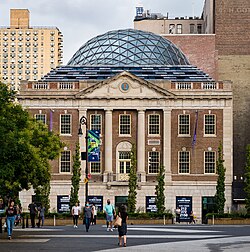| 44 Union Square | |
|---|---|
 Exterior of 44 Union Square in August 2021 | |
 | |
| Alternative names | 100 East 17th Street, Tammany Hall Building |
| General information | |
| Type | Office, retail |
| Architectural style | Neo-Georgian |
| Location | Union Square, Manhattan |
| Address | 44 Union Sq E |
| Town or city | New York City |
| Country | United States |
| Coordinates | 40°44′11″N 73°59′20″W / 40.73639°N 73.98889°W |
| Named for | Tammany Hall |
| Groundbreaking | 1928 |
| Opened | July 4, 1929 |
| Renovated | 2016–2020 |
| Cost | $8 million |
| Renovation cost | $63 million |
| Landlord | Liberty Theatres |
| Technical details | |
| Floor count | 3 |
| Design and construction | |
| Architect(s) | Thompson, Holmes & Converse and Charles B. Meyers |
| Renovating team | |
| Architect(s) | BKSK Architects |
| Designated | November 29, 2013 |
| Reference no. | 2490 |
44 Union Square, also known as 100 East 17th Street and the Tammany Hall Building, is a three-story building at 44 Union Square East in Union Square, Manhattan, in New York City. It is at the southeast corner of Union Square East/Park Avenue South and East 17th Street. The neo-Georgian structure was erected in 1928–1929 and designed by architects Thompson, Holmes & Converse and Charles B. Meyers for the Tammany Society political organization, also known as Tammany Hall. It is the organization's oldest surviving headquarters building.
The Tammany Society had relocated to 44 Union Square from a previous headquarters on nearby 14th Street. At the time of the building's commission, the society was at its maximum political popularity with members such as U.S. senator Robert F. Wagner, governor Al Smith, and mayor Jimmy Walker. However, after Tammany Hall lost its influence in the 1930s, the building was sold to an affiliate of the International Ladies' Garment Workers' Union in 1943. By the 1980s, it was used by the Union Square Theatre, while the New York Film Academy took space in 1994.
The New York City Landmarks Preservation Commission designated the building as a city landmark in 2013, and it was converted into an office and retail structure during a renovation that took place between 2016 and 2020. The renovation preserved the facade while totally gutting the interior, and a glass domed roof was added to honor Chief Tamanend, namesake of the Tammany Society.